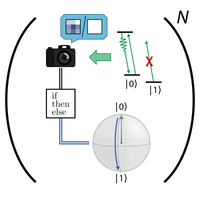Repetitive Readout and Real-Time Control of Nuclear Spin Qubits in 171Yb Atoms
IF 11
Q1 PHYSICS, APPLIED
引用次数: 2
Abstract
We demonstrate high-fidelity repetitive measurements of nuclear spin qubits in an array of neutral ytterbium-171 (171Yb) atoms. We show that the qubit state can be measured with a spin-flip probability of 0.004(4) for a single tweezer and 0.012(3) averaged over the array. This is accomplished by high cyclicity of one of the nuclear spin qubit states with an optically excited state under a magnetic field of B=58 G, resulting in a spin-flip probability of approximately 10−5 per scattered photon during fluorescence readout. The performance improves further as ∼1/B2. The state discrimination fidelity is 0.993(4) with a state-averaged readout survival of 0.994(3), limited by off-resonant scattering to dark states. We combine our measurement technique with high-contrast rotations of the nuclear spin qubit via an ac magnetic field to explore two paradigmatic scenarios, including the noncommutativity of measurements in orthogonal bases, and the quantum Zeno mechanism in which measurements “freeze” coherent evolution. Finally, we employ real-time feedforward to repetitively and deterministically prepare the qubit in the +z or −z direction after initializing it in a different basis and performing a measurement in the Z basis. These capabilities constitute an important step towards adaptive quantum circuits with atom arrays.10 MoreReceived 10 May 2023Accepted 21 August 2023DOI:https://doi.org/10.1103/PRXQuantum.4.030337Published by the American Physical Society under the terms of the Creative Commons Attribution 4.0 International license. Further distribution of this work must maintain attribution to the author(s) and the published article's title, journal citation, and DOI.Published by the American Physical SocietyPhysics Subject Headings (PhySH)Research AreasAtomic, optical & lattice clocksQuantum algorithms & computationQuantum controlQuantum information processingQuantum measurementsQuantum Information, Science & TechnologyAtomic, Molecular & Optical

171Yb原子中核自旋量子比特的重复读出和实时控制
我们展示了中性钇-171 (171Yb)原子阵列中核自旋量子位的高保真重复测量。我们证明了量子比特状态可以用单个镊子的自旋翻转概率为0.004(4)和阵列上的平均0.012(3)来测量。这是通过在B=58 G的磁场下具有光学激发态的一个核自旋量子比特态的高循环度来实现的,导致荧光读出期间每个散射光子的自旋翻转概率约为10−5。在~ 1/B2时,性能进一步提高。状态识别保真度为0.993(4),状态平均读出存活率为0.994(3),受非共振散射到暗态的限制。我们将我们的测量技术与核自旋量子比特通过交流磁场的高对比度旋转结合起来,探索两种典型场景,包括正交基测量的非对易性,以及测量“冻结”相干演化的量子Zeno机制。最后,我们采用实时前馈,在不同基上初始化量子位并在z基上进行测量后,在+z或- z方向上重复和确定性地制备量子位。这些能力构成了原子阵列自适应量子电路的重要一步根据知识共享署名4.0国际许可协议,美国物理学会doi:https://doi.org/10.1103/PRXQuantum.4.030337Published。这项工作的进一步分发必须保持作者的归属和已发表文章的标题,期刊引用和DOI。发表于美国物理学会物理学科标题(PhySH)研究领域原子、光学与晶格时钟量子算法与计算量子控制量子信息处理量子测量量子信息科学与技术原子、分子与光学
本文章由计算机程序翻译,如有差异,请以英文原文为准。
求助全文
约1分钟内获得全文
求助全文

 求助内容:
求助内容: 应助结果提醒方式:
应助结果提醒方式:


